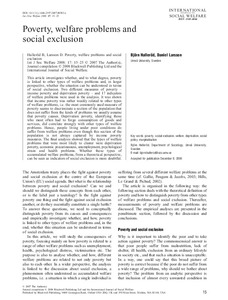Poverty, welfare problems and social exclusion

Halleröd, Björn ; Larsson, Daniel
International Journal of Social Welfare
2008
17
15-25
poverty ; social exclusion ; social policy ; welfare economics
Income distribution
English
Bibliogr.
"This article investigates whether, and to what degree, poverty is linked to other types of welfare problems and, in larger perspective, whether the situation can be understood in terms of social exclusion. Two different measures of poverty – income poverty and deprivation poverty – and 17 indicators of welfare problems were used in the analysis. It was shown that income poverty was rather weakly related to other types of welfare problems, i.e. the most commonly used measure of poverty seems to discriminate a section of the population that does not suffer from the kinds of problems we usually assume that poverty causes. Deprivation poverty, identifying those who most often had to forgo consumption of goods and services, did correlate strongly with other types of welfare problems. Hence, people living under poor conditions do suffer from welfare problems even though this section of the population is not always captured by income poverty measures. The final analysis showed that the types of welfare problems that were most likely to cluster were deprivation poverty, economic precariousness, unemployment, psychological strain and health problems. Whether these types of accumulated welfare problems, from a theoretical perspective, can be seen as indicators of social exclusion is more doubtful."
Digital
The ETUI is co-funded by the European Union. Views and opinions expressed are however those of the author(s) only and do not necessarily reflect those of the European Union or the ETUI.